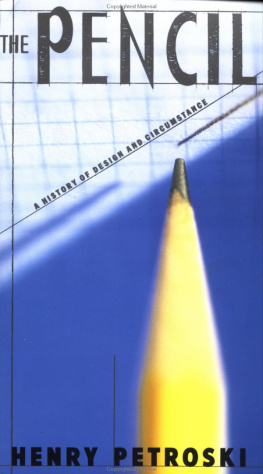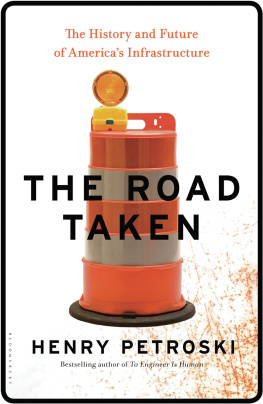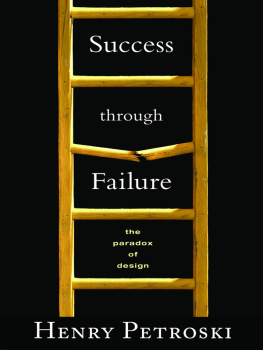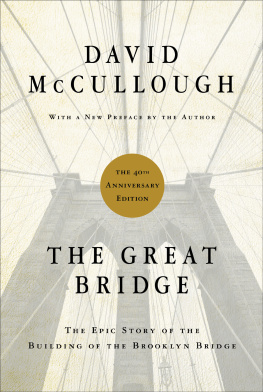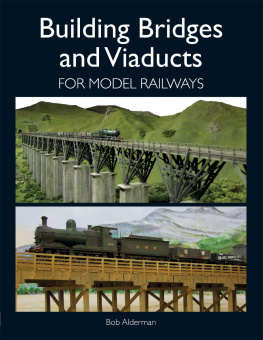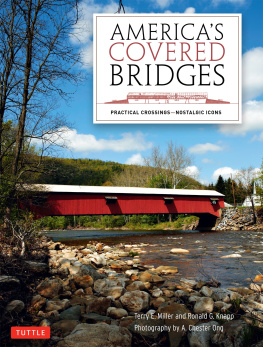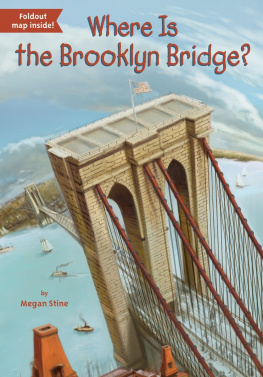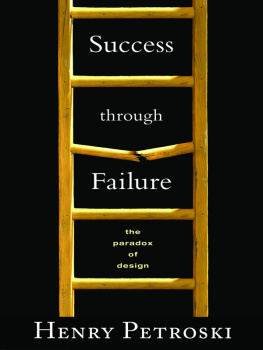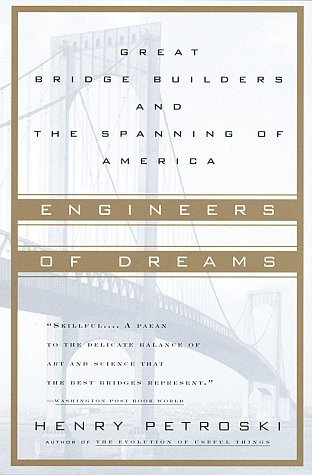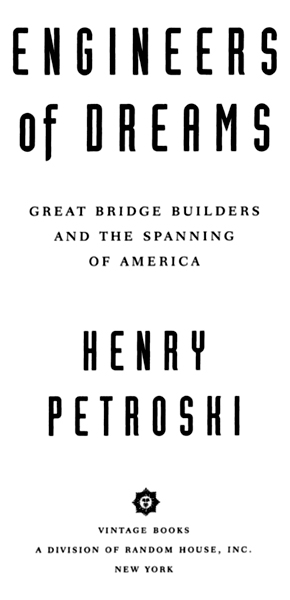ACCLAIM FOR
HENRY PETROSHI
Petroski is an amiable and lucid writer. [He] belongs with the poets.
John Updike, The New Yorker
A triumph. Reading Engineers of Dreams is akin to sitting at the knee of a favorite uncle who spins golden yarns of far-off places and events. There truly is something here for everyone.
Morning Star-Telegram (Fort Worth, Texas)
Henry Petroski is like a bright light sent from heaven.
Durham Morning-Herald
An engaging, entertaining history.
News and Observer (Raleigh, North Carolina)
Just as a good bridge weds sweeping visual grace with detailed mechanical calculations, Engineers of Dreams exhibits a rare mixture of eloquence and precision. That combination has made classics of Petroskis previous books, and his latest deserves no less of a reception.
Invention and Technology
Engineers of Dreams makes [bridges] ever more marvelous.
Rocky Mountain News
FIRST VINTAGE BOOKS EDITION, OCTOBER 1996
Copyright1995 by Henry Petroski
All rights reserved under International and Pan-American Copyright Conventions. Published in the United States by Vintage Books, a division of Random House, Inc., New York, and simultaneously in Canada by Random House of Canada Limited, Toronto. Originally published in hardcover by Alfred A. Knopf, Inc., New York, in 1995.
The Library of Congress has catalogued
the Knopf edition as follows:
Petroski, Henry.
Engineers of dreams: great bridge builders
and the spanning of America. / Henry Petroski. 1st ed.
p. cm.
eISBN: 978-0-307-77313-5
1. BridgesUnited StatesHistory19th century.
2. BridgesUnited StatesHistory20th century.
3. Civil engineersUnited StatesBiography. I. Title.
TG23.P47 1995
624.20973 DC 20 94-48893
Random House Web address: http://www.randomhouse.com/
v3.1
to Catherine
CONTENTS
PREFACE
This book tells the stories of engineers who have dreamed and engineers who have toiled, of bridges of celebrity and bridges of burden, and it is about the nature of technology in a human context. Some renowned engineers and some famous bridges have tended to overshadow their contemporaries and neighbors, but the full range of stories reveals that the lesser-known engineers have been of no less importance in shaping our built environment. Indeed, the personalities of all kinds of engineers, with their faults and foibles coexisting with their dreams and designs, have played as much of a role as has their technical know-how in bringing familiar bridges to fruition.
As is to be expected, only some of the bridges of which any engineer dreams get realized, but that is not to say that even the wildest schemes have not influenced others, and hence our roadscapes. A full understanding of how and why a great bridge came to be what it is where it is requires appreciating the often decades-long struggles that engineers have experienced with themselves, their colleagues, and their communities. In telling the stories of some engineers and some bridges, this book must necessarily tell the stories of many bridges and many engineers engaged in the professional, economic, political, and personal conflicts that occur in the technical, social, and cultural activities in which we all participate. When we see in the stories of bridges the full human dimensions of engineers and engineering, we also see more clearly the inextricable interrelationships between technology and humanity. As no person is an island, so no thing is an island. Certainly no bridge is an island.
And no book is an island. Many bridges were provided by many people on the way to this books being realized, and I wish to acknowledge and thank at least some of them. Arthur Singer turned my rough sketch of an idea into a grant from the Alfred P. Sloan Foundation, which enabled me to travel to bridge sites, to gather illustrations, and to write. Ashbel Green, my editor at Knopf, has once again given me my head and his support. Anne T. Zaroff-Evans did a marvelous job of copy-editing, and Knopfs Jennifer Bernstein and Melvin Rosenthal also made the process from manuscript to book a smooth one, at least from my point of view.
There was also, of course, much help long before there was a manuscript, and libraries and librarians were, as always, remarkably tolerant of my inquiries. The wonderful collection of the Aleksandar S. Vesi Engineering Library at Duke University continues to provide resources and convenience of immeasurable value. Eric Smith, its former librarian, who was forever patient with my endless requests, located and obtained for me important materials so diverse that no one institution could ever be expected to contain them all. Rich Hines and Dianne Himler have continued to get to me the many odd library materials that are so essential in the final stages of preparing a manuscript. The resources and facilities of Dukes main library, the William R. Perkins Library, have once again been indispensable to me, as has the institution of Interlibrary Loan. I have also had much help from archives, historical societies, bridge authorities, and departments of transportation in locating information and photographs; the sources of these pictures are credited in the list of illustrations in the back of the book. Indeed, I am indebted to so many librarians, archivists, secretaries, assistants, and volunteers, at Duke and elsewhere, both known to me and anonymous, that I dare not begin to acknowledge them by name, lest I forget one.
I must, however, thank some other individuals by name. My brother, William Petroski, helped me early on to get a closer look at many New York bridges, and my sister, Marianne Petroski, gave me some helpful books. Stephen Petroski, my son and a student engineer, also helped me very early on by collecting essential material from newspaper indexes, and Ian Threlfall, a graduate student in civil and environmental engineering at Duke, later retrieved countless remarkably clear copies of articles from microfilm files. Margot Ammann Durrer kindly provided me with much material relating to her father, including letters and photographs. A host of engineers and friends of engineers have helped me with very useful material and leads, and I would like to thank especially Norman Ball, David Billington, Milton Brumer, Stephen Burges, Jameson Doig, Eugene Fasullo, Steven Fenves, Henry Fischer, Jay Fredrich, Myint Lwin, Louis Miller, W. S. Persons, Allan Ryan, Thomas Sullivan, and Neil Wotherspoon. I also wish to thank my daughter Karen Petroski for her insights into scholarship. Finally, I am as always indebted to Catherine Petroski, my wife, for being my first reader and most constructive critic, and for understanding, at times perhaps even better than I, my writing habits and needs.
H.P.
Durham, North Carolina
September 1994

IMAGINE
I magine a world without bridges. Imagine London, Paris, and Rome without dry paths across the Thames, the Seine, and the Tiber. Imagine Manhattan as an island with no hard crossings of the Hudson and East rivers. Imagine San Francisco without road communication across the gate to the north and the bay to the east. Imagine Pittsburgh wedged bridgeless between the Allegheny and the Monongahela rivers. Imagine Chicago without its massive lift- and drawbridges, or Amsterdam without its more modest canal crossings. Imagine Seattle without its long, low floating bridges, or St. Petersburg without its soaring cable-stayed structure arcing out over Tampa Bay.



